Abstract
1. In human subjects, sustained static contractions of the knee extensors were performed in one leg with the same absolute (10% of the initial maximal voluntary contraction) and relative (30% of the maximal voluntary contraction immediately prior to the static exercise) intensities before and during epidural anaesthesia. Epidural anaesthesia reduced strength to 62 +/- 8% of the control value and partially blocked sensory input from the working muscles. During contractions performed with the same relative force, the increases in mean arterial pressure and heart rate were greater during control contractions than during epidural anaesthesia. During contractions at the same absolute force, there was no significant difference in magnitude of cardiovascular responses between control contractions and contractions performed during epidural anaesthesia. 2. The metabolic role in the exercise pressor reflex was assessed by applying an arterial leg cuff 10 s before cessation of exercise and through the following 3 min of recovery. Although mean arterial pressure and heart rate decreased immediately after cessation of exercise, application of the arterial occlusion cuff resulted in higher post-exercise mean arterial pressure and heart rate values. Control and epidural mean arterial pressures during arterial occlusion were not significantly different. 3. The results of this study suggest that the reflex neural mechanism rather than the intended effort (central command) is important in determining the blood pressure and heart rate responses to static exercise in man. That is, when epidural anaesthesia diminishes sensory feedback and produces muscular weakness, central command does not determine the cardiovascular response. This conclusion, however, is opposite to that derived from experiments with partial neuromuscular blockade which demonstrated the importance of central command in determining the cardiovascular response to static exercise (Leonard, Mitchell, Mizuno, Rube, Saltin & Secher, 1985). Taken together, these two studies are complementary and support the concept that both central and reflex neural mechanisms play roles in regulating arterial blood pressure and heart rate during static exercise in man.
Full text
PDF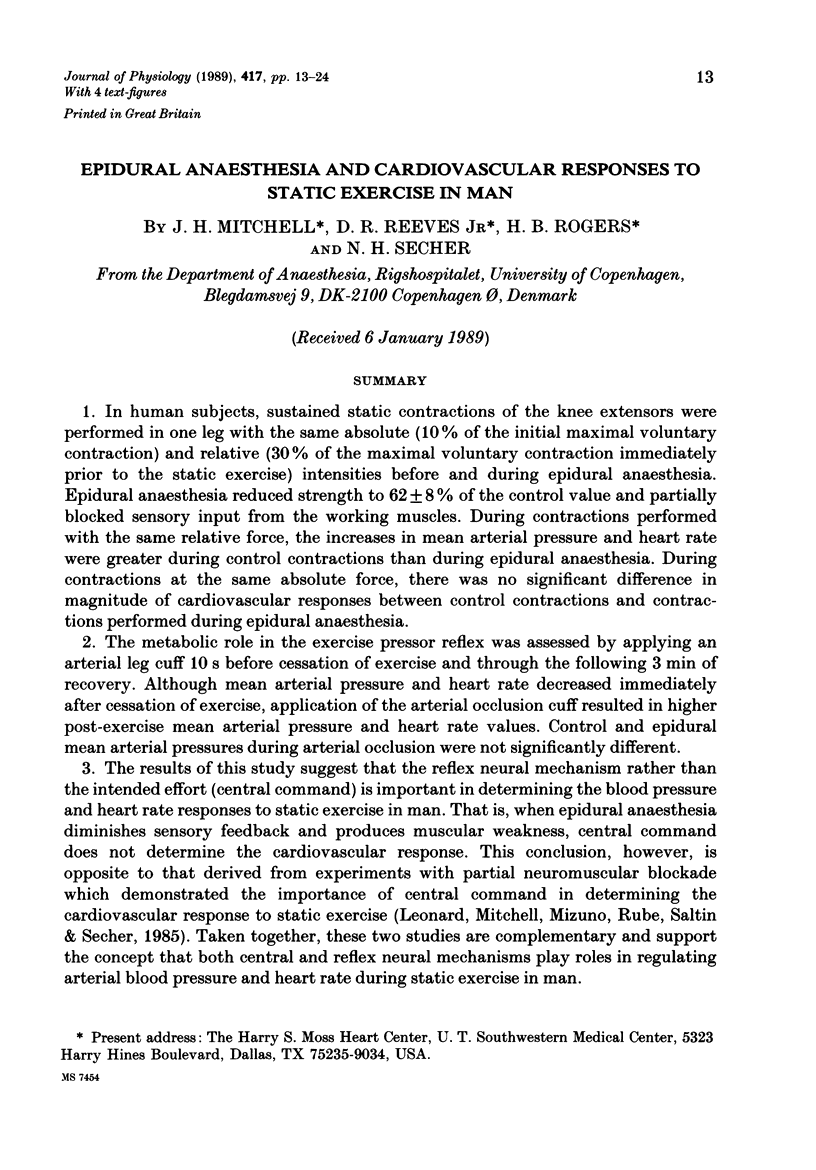


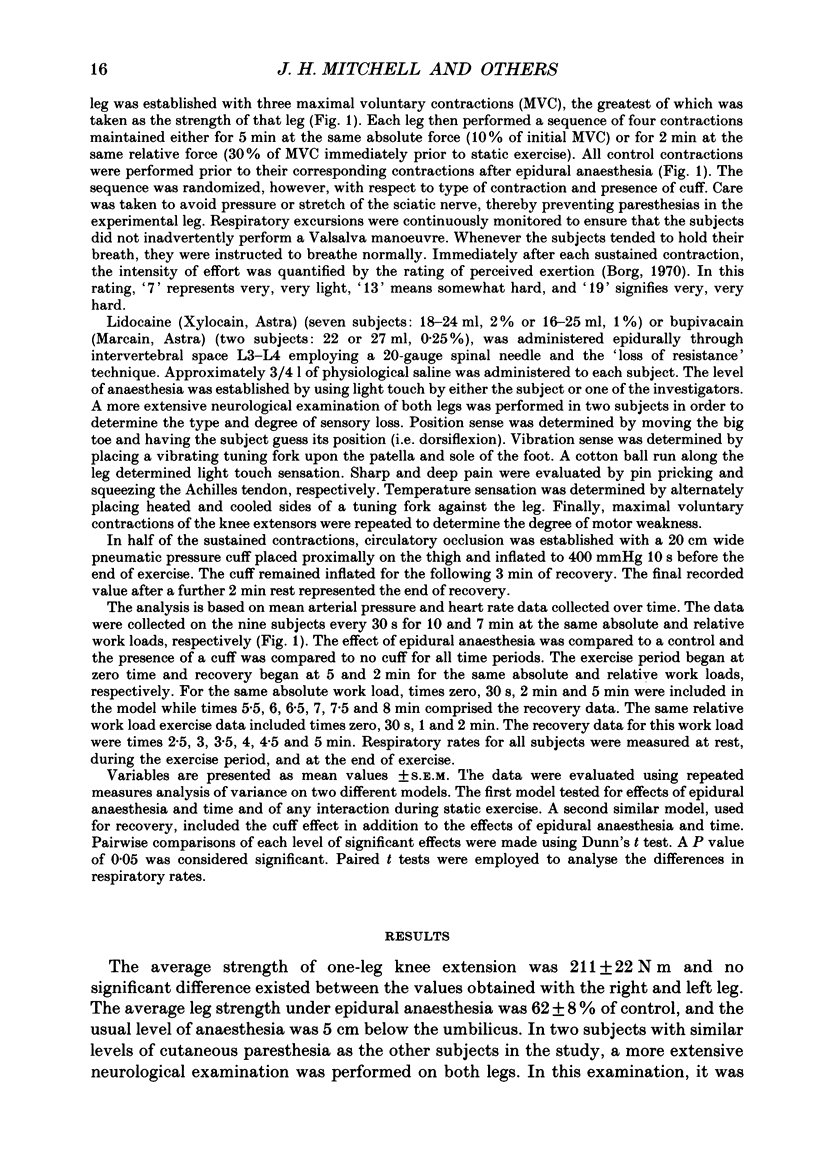

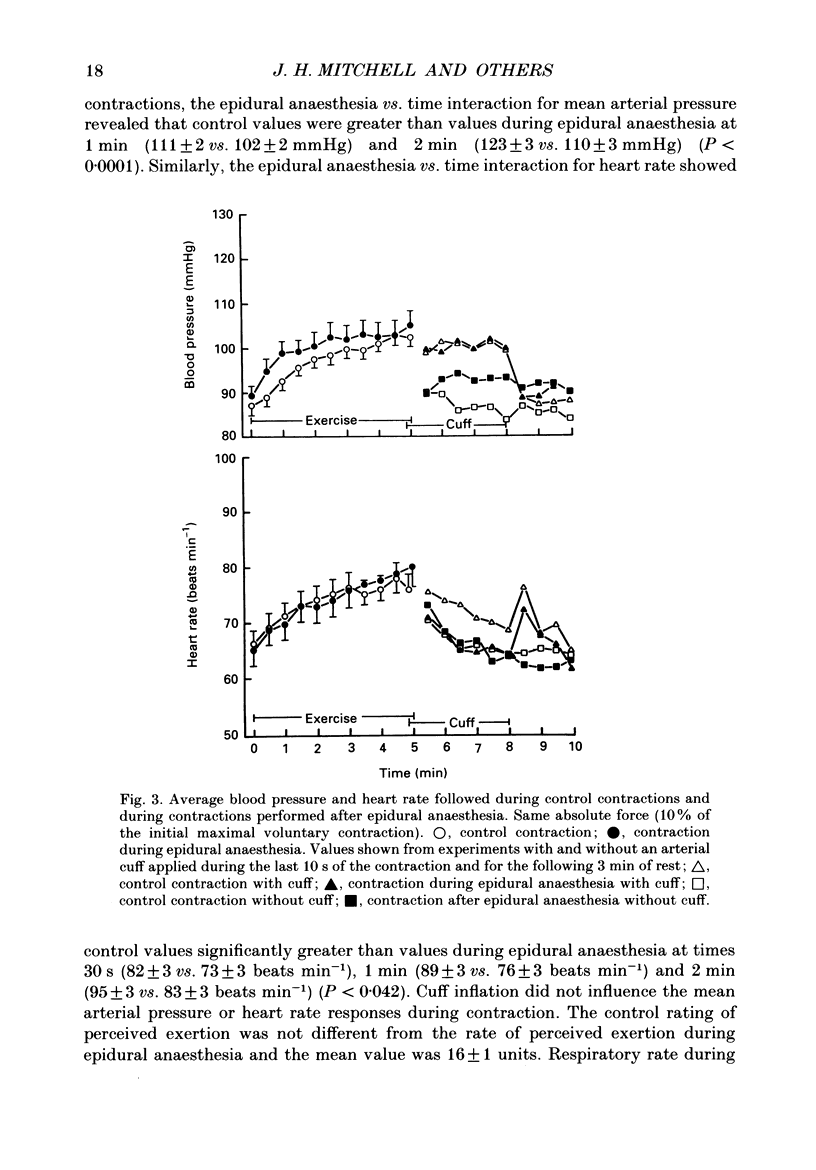



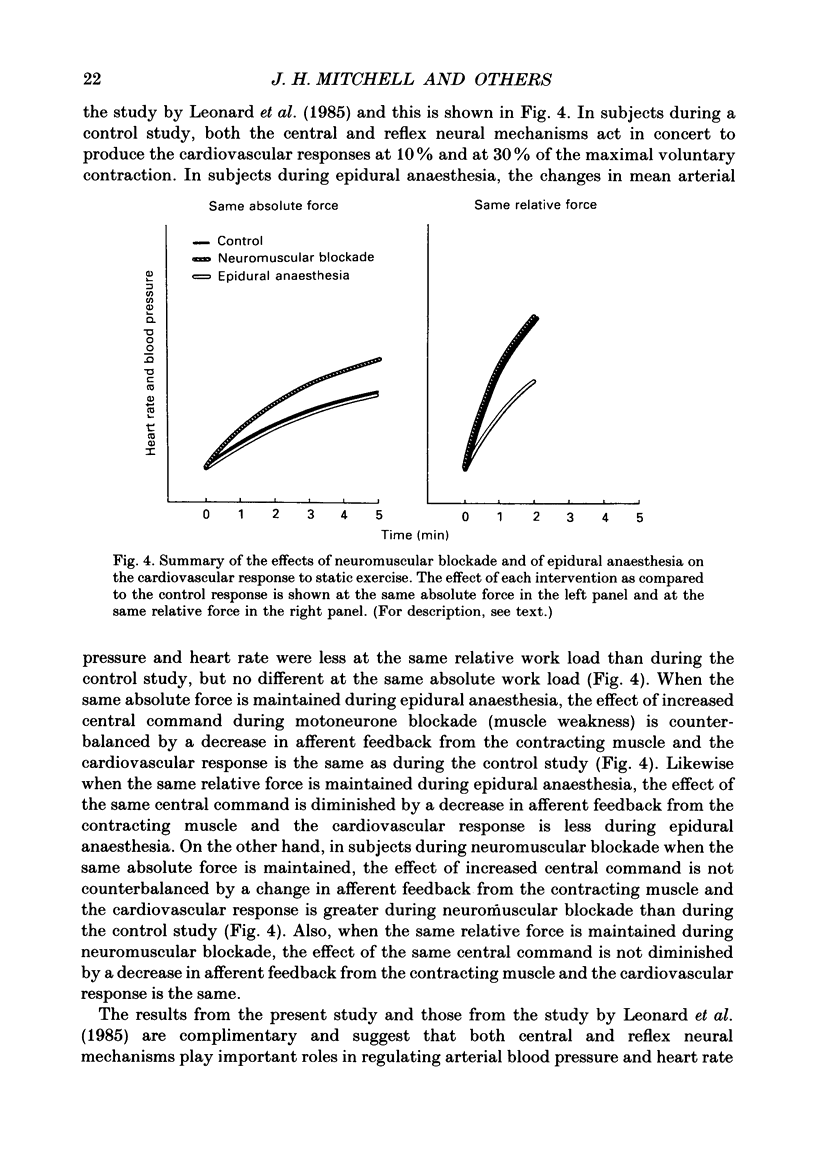
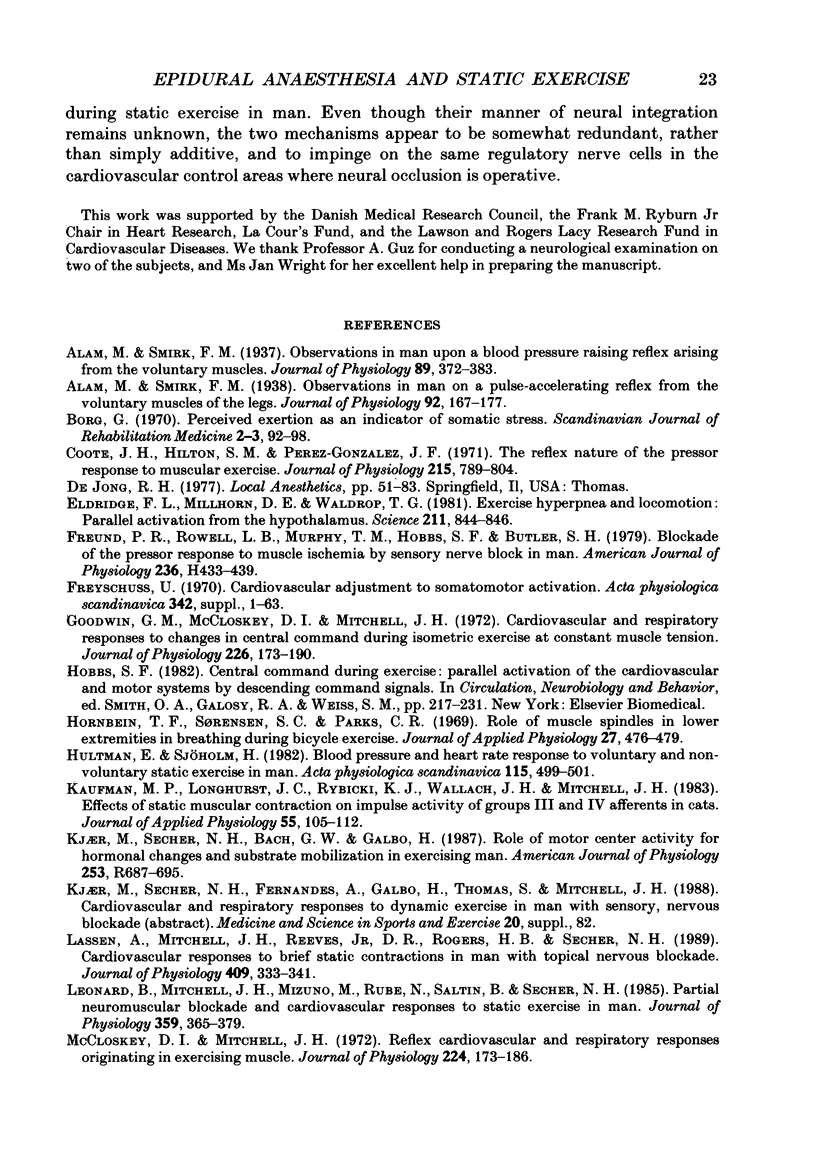
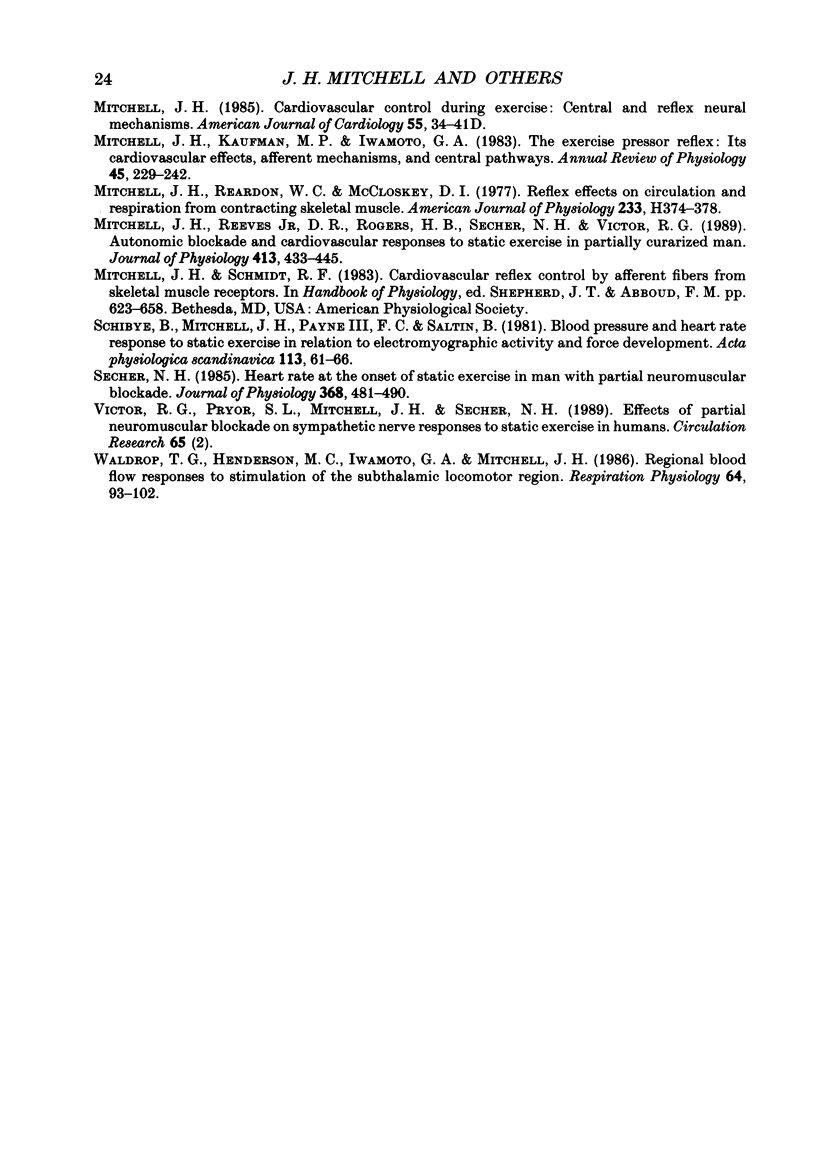
Selected References
These references are in PubMed. This may not be the complete list of references from this article.
- Alam M., Smirk F. H. Observations in man on a pulse-accelerating reflex from the voluntary muscles of the legs. J Physiol. 1938 Mar 14;92(2):167–177. doi: 10.1113/jphysiol.1938.sp003592. [DOI] [PMC free article] [PubMed] [Google Scholar]
- Alam M., Smirk F. H. Observations in man upon a blood pressure raising reflex arising from the voluntary muscles. J Physiol. 1937 Jun 3;89(4):372–383. doi: 10.1113/jphysiol.1937.sp003485. [DOI] [PMC free article] [PubMed] [Google Scholar]
- Borg G. Perceived exertion as an indicator of somatic stress. Scand J Rehabil Med. 1970;2(2):92–98. [PubMed] [Google Scholar]
- Coote J. H., Hilton S. M., Perez-Gonzalez J. F. The reflex nature of the pressor response to muscular exercise. J Physiol. 1971 Jul;215(3):789–804. doi: 10.1113/jphysiol.1971.sp009498. [DOI] [PMC free article] [PubMed] [Google Scholar]
- Eldridge F. L., Millhorn D. E., Waldrop T. G. Exercise hyperpnea and locomotion: parallel activation from the hypothalamus. Science. 1981 Feb 20;211(4484):844–846. doi: 10.1126/science.7466362. [DOI] [PubMed] [Google Scholar]
- Freund P. R., Rowell L. B., Murphy T. M., Hobbs S. F., Butler S. H. Blockade of the pressor response to muscle ischemia by sensory nerve block in man. Am J Physiol. 1979 Oct;237(4):H433–H439. doi: 10.1152/ajpheart.1979.237.4.H433. [DOI] [PubMed] [Google Scholar]
- Freyschuss U. Cardiovascular adjustment to somatomotor activation. The elicitation of increments in heart rate, aortic pressure and venomotor tone with the initiation of muscle contraction. Acta Physiol Scand Suppl. 1970;342:1–63. [PubMed] [Google Scholar]
- Goodwin G. M., McCloskey D. I., Mitchell J. H. Cardiovascular and respiratory responses to changes in central command during isometric exercise at constant muscle tension. J Physiol. 1972 Oct;226(1):173–190. doi: 10.1113/jphysiol.1972.sp009979. [DOI] [PMC free article] [PubMed] [Google Scholar]
- Hornbein T. F., Sorensen S. C., Parks C. R. Role of muscle spindles in lower extremities in breathing during bicycle exercise. J Appl Physiol. 1969 Oct;27(4):476–479. doi: 10.1152/jappl.1969.27.4.476. [DOI] [PubMed] [Google Scholar]
- Hultman E., Sjöholm H. Blood pressure and heart rate response to voluntary and nonvoluntary static exercise in man. Acta Physiol Scand. 1982 Aug;115(4):499–501. doi: 10.1111/j.1748-1716.1982.tb07110.x. [DOI] [PubMed] [Google Scholar]
- Kaufman M. P., Longhurst J. C., Rybicki K. J., Wallach J. H., Mitchell J. H. Effects of static muscular contraction on impulse activity of groups III and IV afferents in cats. J Appl Physiol Respir Environ Exerc Physiol. 1983 Jul;55(1 Pt 1):105–112. doi: 10.1152/jappl.1983.55.1.105. [DOI] [PubMed] [Google Scholar]
- Kjaer M., Secher N. H., Bach F. W., Galbo H. Role of motor center activity for hormonal changes and substrate mobilization in humans. Am J Physiol. 1987 Nov;253(5 Pt 2):R687–R695. doi: 10.1152/ajpregu.1987.253.5.R687. [DOI] [PubMed] [Google Scholar]
- Lassen A., Mitchell J. H., Reeves D. R., Jr, Rogers H. B., Secher N. H. Cardiovascular responses to brief static contractions in man with topical nervous blockade. J Physiol. 1989 Feb;409:333–341. doi: 10.1113/jphysiol.1989.sp017500. [DOI] [PMC free article] [PubMed] [Google Scholar]
- Leonard B., Mitchell J. H., Mizuno M., Rube N., Saltin B., Secher N. H. Partial neuromuscular blockade and cardiovascular responses to static exercise in man. J Physiol. 1985 Feb;359:365–379. doi: 10.1113/jphysiol.1985.sp015590. [DOI] [PMC free article] [PubMed] [Google Scholar]
- McCloskey D. I., Mitchell J. H. Reflex cardiovascular and respiratory responses originating in exercising muscle. J Physiol. 1972 Jul;224(1):173–186. doi: 10.1113/jphysiol.1972.sp009887. [DOI] [PMC free article] [PubMed] [Google Scholar]
- Mitchell J. H., Kaufman M. P., Iwamoto G. A. The exercise pressor reflex: its cardiovascular effects, afferent mechanisms, and central pathways. Annu Rev Physiol. 1983;45:229–242. doi: 10.1146/annurev.ph.45.030183.001305. [DOI] [PubMed] [Google Scholar]
- Mitchell J. H., Reardon W. C., McCloskey D. I. Reflex effects on circulation and respiration from contracting skeletal muscle. Am J Physiol. 1977 Sep;233(3):H374–H378. doi: 10.1152/ajpheart.1977.233.3.H374. [DOI] [PubMed] [Google Scholar]
- Mitchell J. H., Reeves D. R., Jr, Rogers H. B., Secher N. H., Victor R. G. Autonomic blockade and cardiovascular responses to static exercise in partially curarized man. J Physiol. 1989 Jun;413:433–445. doi: 10.1113/jphysiol.1989.sp017662. [DOI] [PMC free article] [PubMed] [Google Scholar]
- Schibye B., Mitchell J. H., Payne F. C., Saltin B. Blood pressure and heart rate response to static exercise in relation to electromyographic activity and force development. Acta Physiol Scand. 1981 Sep;113(1):61–66. doi: 10.1111/j.1748-1716.1981.tb06862.x. [DOI] [PubMed] [Google Scholar]
- Secher N. H. Heart rate at the onset of static exercise in man with partial neuromuscular blockade. J Physiol. 1985 Nov;368:481–490. doi: 10.1113/jphysiol.1985.sp015870. [DOI] [PMC free article] [PubMed] [Google Scholar]
- Waldrop T. G., Henderson M. C., Iwamoto G. A., Mitchell J. H. Regional blood flow responses to stimulation of the subthalamic locomotor region. Respir Physiol. 1986 Apr;64(1):93–102. doi: 10.1016/0034-5687(86)90063-0. [DOI] [PubMed] [Google Scholar]


